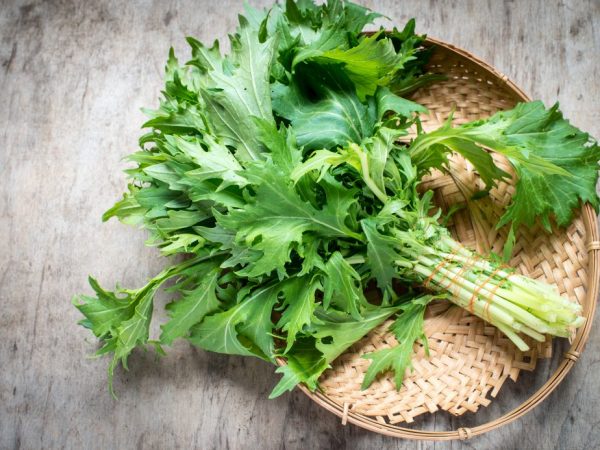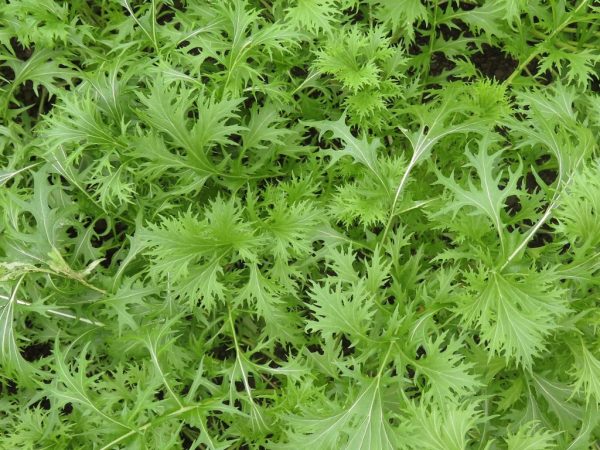Characteristics of cabbage varieties Japanese Mermaid
Mizuna salad or Japanese mermaid cabbage is one of the most common varieties of Japanese salad. Due to its high taste and a huge amount of vitamins, it is often used both for salads and cold snacks, and for preparing hot dishes.

Characteristics of cabbage varieties Japanese Mermaid
Characteristics of the variety
Japanese cabbage is an annual vegetable that belongs to the brassica family. The peculiarity of these varieties is that when the leaves are cut, they grow back again. The little mermaid was bred by Japanese breeders as a more stem-resistant variety. This species is distinguished by its early high yield. Already after 2 months, subject to good care, the first heads of cabbage may appear.
Description of the head
Due to the large number of upper buds, the vegetable has a spreading leaf rosette of more than 50 green leaves, with a thin white vein. The height of the plant is slightly more than half a meter. The foliage surface is smooth or slightly wrinkled, dissected into parts with jagged edges.
The leaves taste tender, have a pleasant freshness and light salad aroma. The weight of one head of cabbage, on average, is about 1.5 kg.
Application of the vegetable
Cabbage leaves are consumed raw and in various dishes. Most often added to:
- salads;
- sandwiches;
- cold snacks;
- soups;
- stew;
- marinades;
- pickles.
Mizun salad is a good addition to meat and fish dishes, as cabbage leaves have a slight peppery aroma. It is also good to use in combination with flavored cheeses.
Due to the small amount of mustard oils in the vegetable, Japanese cabbage can be consumed by people who suffer from ulcers, gastritis and diseases of the cardiovascular system.
The little mermaid is also used for decoration and decoration of personal plots and flower beds. Also, thanks to the unusual shape of the leaves of the vegetable, they are decorated with alpine slides and borders.
Growing features
Japanese cabbage The Little Mermaid is unpretentious in cultivation. Hot and cold-resistant vegetable
Cabbage loves a soil with a high organic composition, drained and medium loamy. The plant is hygrophilous, but does not tolerate frequent waterlogging of the soil.
Soil preparation
It is recommended to prepare beds for growing this crop from early autumn.
For 1 m2, make:
- at least 5 kg of humus;
- 15-20 g of superphosphate fertilizers;
- 20 g of potash fertilizers.
In early spring, before sowing the plant, the soil must be fertilized with ammonium nitrate (at least 20 g per 1 sq. M.).
Sowing seeds

Cabbage can be grown as seedlings
It is possible to grow both seedlings and in open ground.
In open ground
Seeds are sown from mid-April to early May. The first shoots appear at a temperature of about 4 ° C. Seedlings are resistant to cold weather and light frosts, they can withstand spring frosts down to -4 ° С.The most optimal temperature for plant growth in the open field is 16-29 ° С
Seedling method
To obtain an earlier harvest, it is recommended to sow vegetable seeds for seedlings. This is best done in mid-March, and planted in the ground in May. Seed germination occurs already on the third day after sowing.
Care rules
For a favorable cultivation of cabbage and a good harvest throughout the season, you must follow 3 simple rules:
- Regular weeding.
- Loosening of row spacings.
- Competent watering.
Fertilizers
It's very important not to overdo it with fertilizers. The plant can accumulate nitrates from soil with a high nitrogen content. It is necessary to limit yourself to two supporting dressings in the ground before sowing seeds. Fertilizers, which include potassium and phosphorus, have a beneficial effect. It is recommended to make them at least twice a season. It is necessary to treat nitrogen fertilizers with caution.
It is also recommended to cut off ripe leaves in a timely manner to enable the formation of young shoots.
Soil and watering
More suitable beds for growing cabbage are those with good lighting and light, fertile soil. It is recommended to fertilize the earth with lime in order to normalize the level of moisture. It is very important not to allow the soil to dry out; regular watering is necessary.
Temperature regime
An increase in air temperature can have a bad effect on the plant. With prolonged heat, sunburn appears on the leaves.
Diseases and pests
Pests
In order to avoid the attack of infectious diseases and pests, it is recommended to grow an exotic plant on the soil where legumes, nightshades or pumpkin crops grew before. It is not recommended to sow cabbage in place of any cruciferous crops.
Vegetable crops are susceptible to the influence of a very dangerous pest - cruciferous flea beetles. The peak of the pest attack is early spring, when the air temperature is stable at 15 ° C. The presence of flea beetles is indicated by holes in the leaves and shoots of cabbage.
Pest control
| № | Method of struggle | Description |
| 1. | Humid environment | It is necessary to maintain a moist environment by watering the seedlings abundantly. It is very effective to plant the crop in more humid areas of the garden. |
| 2. | Dusting a plant | 1. Mix wood ash with lime in equal amounts. 2. Ash and tobacco dust. |
| 3. | Dusting the earth | 1. Tobacco dust. 2. Naphthalene. |
| 4. | Spraying | 1. A mixture of 1 tbsp. l. steamed ash in 3 tbsp. l. hot water. Insist 48 hours, then add liquid or laundry soap. 2. For half a glass of grated garlic, you need to take the same number of chopped tomato stalks. Pour in warm water (5 l) with the addition of half a tablespoon of soapy water. Spray with a warm mixture. 3. 100 g of any tobacco pour 5 liters of boiling water. Insist for several hours, then filter and add an incomplete tablespoon of soap. 4. For a bucket (9-10 l) of water, you need to take 250 ml of white vinegar (at least 9%). |
| 5. | Scare and prevention | Any material soaked in oil for a car very effectively helps in the fight against a pest. It is necessary to place it between the rows with a vegetable crop, at a distance of at least 4 m. Continue the procedure for three days. |
Diseases
The plant is not very susceptible to the effects of many diseases. Infection with fungal diseases is possible.
| Risk group | Symptoms | Treatment | Prophylaxis | |
| Blackleg | Young seedlings | Darkening and dryness of the lower shoots | Removal of affected areas and root watering with a weak solution of potassium permanganate | Disinfection of seeds with Phytolavin and Bactofil preparations |
| Peronosporosis | Affects both young seedlings and mature plants | Yellow blurry spots on the leaves, like an off-white bloom | Sprayed with fungicides and Bordeaux liquid | Avoid high humidity, avoid density when planting |
| Fomoz | Young and mature seedlings | Dark dotted spots, darkening of the root collar | Spraying with a weak solution (1%) Bordeaux liquid | Disinfection of soil and treatment with potassium permanganate solution |
Conclusion
The Little Mermaid is a variety of Japanese cabbage, which differs not only in useful properties, but also in the possibility of using it for landscape decoration. The convenience of growing this crop only increases its popularity among many gardeners.
Subject to the simple rules of care and timely treatment of pests, the vegetable will delight with fragrant greens from May to late autumn.


